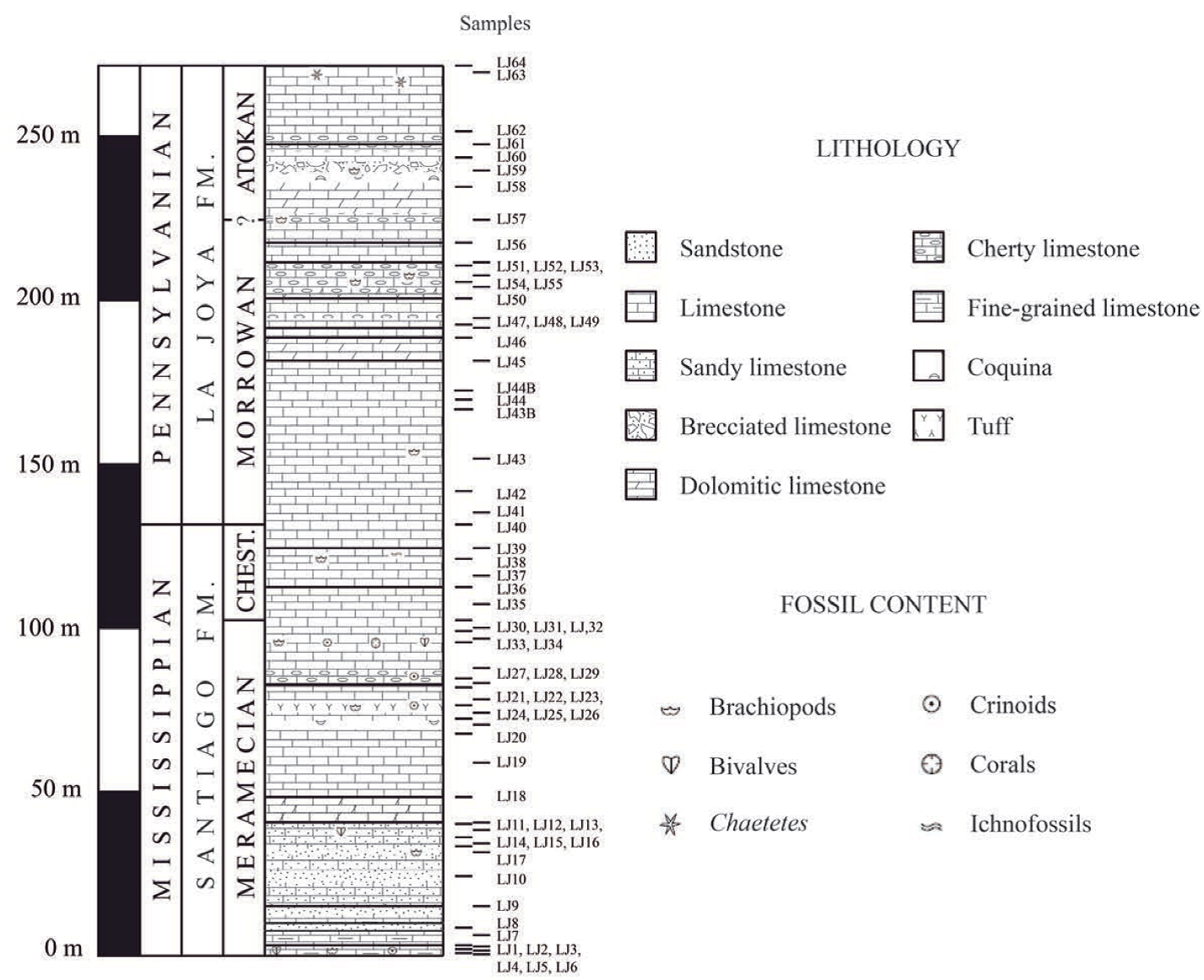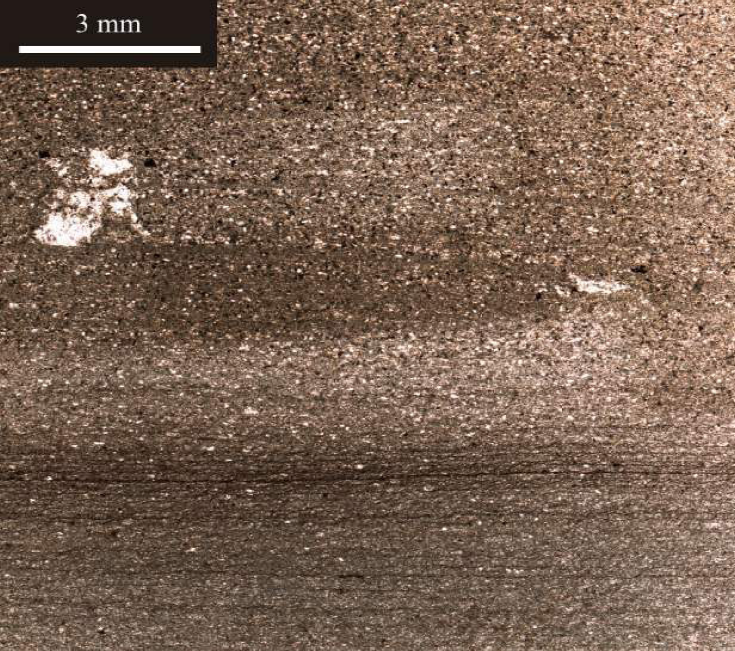1. Introduction
The microfacies analysis has been demonstrated as an important tool to interpret ancient environments (Ekdale et al., 1976; Kietzmann et al., 2008; Coronado and Rodriguez, 2009; Flügel, 2010; Liu et al., 2015; among others). By using the concept of standard microfacies developed by Flügel (1972) to categorize platform and reef carbonates it is possible to recognize the different types of facies zones defined by Wilson (1975), which allow us to allocate carbonate sediments in a particular paleoenvironment according to paleontological and textural criteria.
The Sierra Agua Verde, located in the state of Sonora in northern Mexico, 110 km E of Hermosillo city (Figure 1), is an area that has been poorly studied with regard to microfacies and geochemical analyses. This mountain range, distinguished for its Paleozoic fossil richness, contains rocks of the Agua Verde Group, a carbonate-platform sequence of Ordovician-Lower Permian age (Ochoa-Granillo and Sosa-León, 1993). The fossil biota found is diverse; however, few studies have been published. Gómez-Espinosa et al. (2008) reported the presence of fusulinids and calcareous algae; Buitrón-Sánchez et al. (2007) indicated the existence of a fossil association of phylloid algae, fusulinids, chaetetids, tabulate corals, gastropods, fenestellid bryozoans, productid and spiriferid bra-chiopods, crinoids, and conodonts in fossiliferous limestones belonging to the La Joya formation.
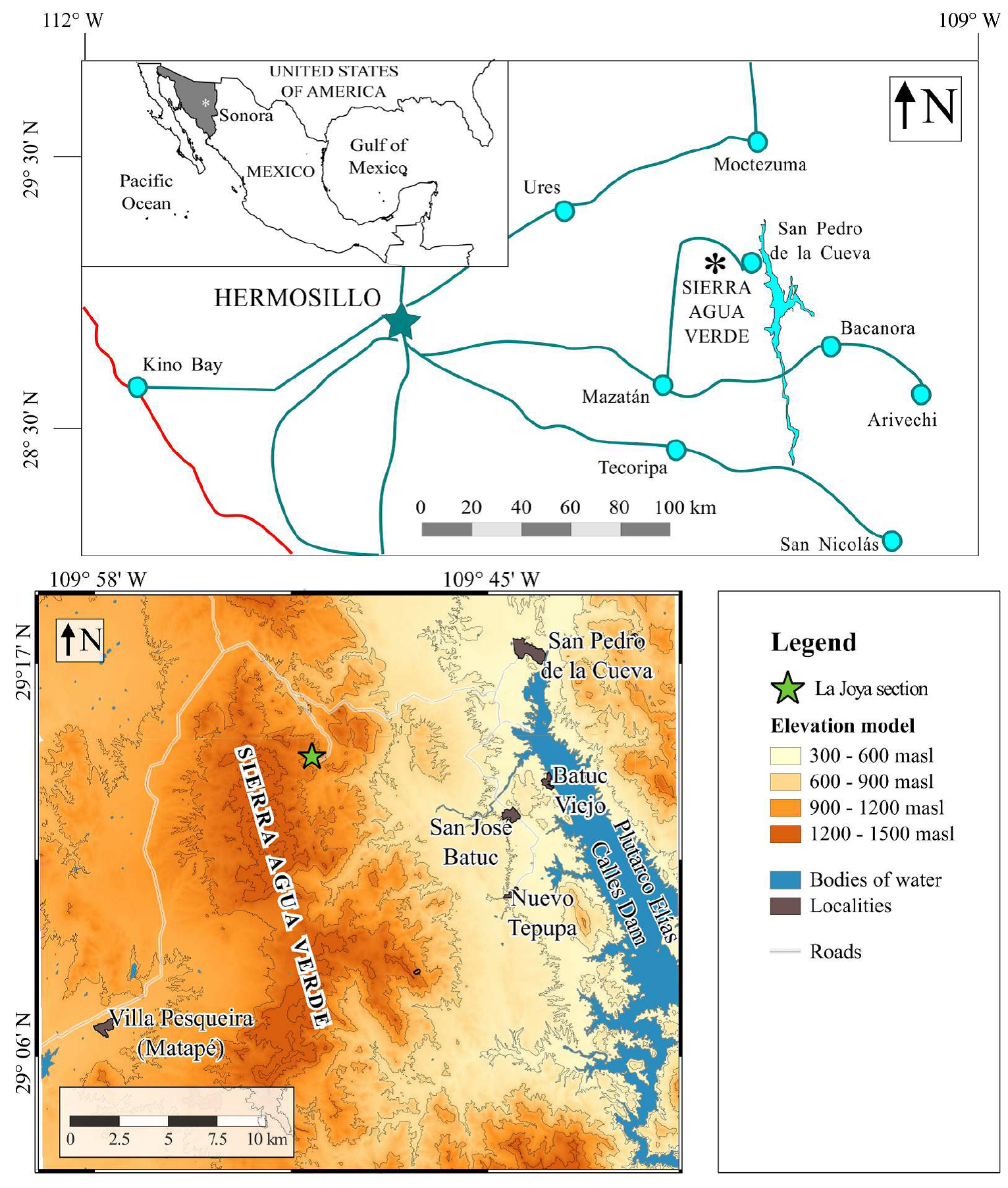
Figure 1 (A) Map of Mexico showing the location of the studied section in Sierra Agua Verde and the state of Sonora. (B) Topographic map of the Sierra Aqua Verde.
Several contributions have also improved the knowledge of the stratigraphy of the area: Stewart et al. (1984, 1988, 1999) were the first to recognize the presence of Paleozoic rocks in the area; Minjarez-Sosa et al. (1993) and Ochoa-Granillo and Sosa-León (1993) described Ordovician, Devonian, Mississipian, Pennsylvanian, and Permian strata. Other important studies that contributed to the understanding of the stratigraphy of the region include those of Repetsky et al. (1985), Gehrels et al. (1995), and Poole et al. (1995).
Ochoa-Granillo and Sosa-León (1993) inferred the depositional environment of the La Joya formation as a shallow platform, with the development of calcareous banks with terrigenous input. Buitrón-Sánchez et al. (2007) concluded that the fossil-iferous association of this unit is typical of tropical shallow seas and shows a strong affinity with species of regions from the south of the United States and the Midcontinent area. However, Almazán-Vázquez et al. (2007) pointed out that the La Joya formation was deposited in a relatively deep-water environment, on the boundary with the photic zone, because of a lack of shallow-water proxies (i.e., algae), and an abundance of crinoids, bryozoans, and brachiopods, interpreted by those authors as indicators of deeper water. On the other hand, Gómez-Espinosa (2010) characterized 12 different microfacies, from base to top, as slope, lagoon, slope, toe of slope, lagoon, slope, lagoon, and reef. Both studies are sustained on a reduced number of samples, which impedes a determinant conclusion. Recently Navas-Parejo et al. (2017) reported different biozones of conodonts in La Joya, and thus defined the ages for this section.
The aim of this work is to unravel the variations among depositional environments within the Carboniferous La Joya section in Sierra Agua Verde. The above by means of a more detailed sampling on that area that allows recognition of variations of petrographic elements through a microfacies analysis. Additionally, 13C and 18O stable isotope curves were analyzed, and their excursion patterns matched with facies associations, bringing some insight in global to regional conditions present during the deposition time of the La Joya sediments.
2. Stratigraphy
2.1. Sierra agua verde stratigraphy
In Sierra Agua Verde (Figure 2), Paleozoic rocks are well exposed in outcrops belonging to the Cambrian San José Group and to the Ordovician-Lower Permian Agua Verde Group. The La Joya and Santiago formations, defined by Ochoa-Granillo and Sosa-León (1993), represent informal lithostratigraphic units with a thickness of 669 m that belong to the Agua Verde Group. The Santiago formation consists of limestones, dolomitized and sandy limestones, and sandstones. The lower part of the formation corresponds to dolomitized gray limestone, intercalated with small horizons of sandstone and 14 cm thick, black chert beds as well. The middle part is composed of sandy limestone and calcareous shale rich in corals, brachiopods, bryozoans, and bivalves.
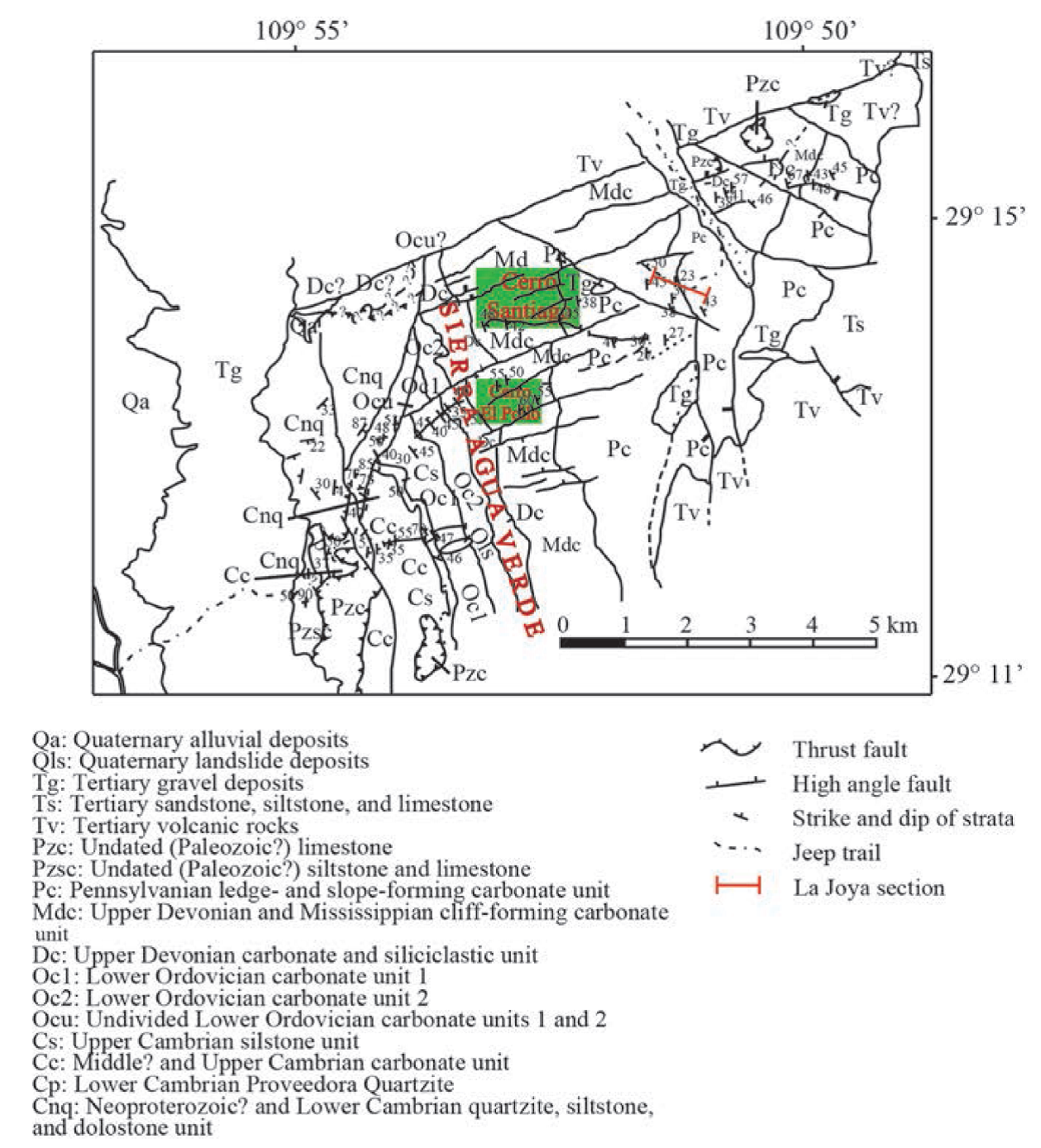
Figure 2 Geologic map of the Sierra Agua Verde area; the measured La Joya section is shown in red (Modified from Stewart et al., 1999).
The upper part of this unit is represented by gray fossiliferous limestone with some black chert lenses, and grades into red shale-sandstone with Syringopora (Ochoa-Granillo and Sosa-León, 1993). According to Ochoa-Granillo and Sosa-León (1993), the Santiago formation was deposited in a platform with development of calcareous banks of colonial organisms and is coetaneous with the Escabrosa and Horquilla formations in the Cabullona area, northeast of Sonora.
This formation underlies and is transitional to the La Joya formation, which has a thickness of 294 m consisting of limestone intercalated with calcareous lodolites and sandy lenses. The base of the La Joya formation is composed of medium to thick, massive, light gray to reddish limestone strata, with small calcareous lodolite intercalations in thinner strata, with black to red chert nodules embedded. Common fossils are the coral Syringopora (middle Silurian-Pennsylvanian), the brachiopod Crurithyris (Devonian-Permian), the bryozoan Glyptopora (Carboniferous), and crinoidal remains.
Above these strata, we found light-gray limestone in fresh rock and blue-gray in weathered surface, with intercalations of calcareous reddish mud-stones. The fossil fauna consists of Syringopora corals, crinoid plates, bryozoans, gastropods, and other shell remains.
At its upper part, it consists of medium-thick gray to reddish limestone strata, intercalated with calcareous red lodolite, and white to red chert nodules and lenses with small dark bands. Fossil fauna consists of the coralline sponge Chaetetes from the middle Pennsylvanian, the bryozoan Fenestrellina of Silurian-Permian age, and the Pennsylvanian-Permian brachiopod Neospirifer.
2.2. La joya section
A 270 m thick section of the La Joya (Pennsylvanian) and Santiago (Mississippian) formations was measured (Figure 3). The lithology of the section is mainly limestone. The 50 m interval at its base corresponds to sandy limestone intercalated with finer-grained limestone. The sandy limestone is overlain by poorly fossiliferous (crinoids, brachiopods, and bivalve shells) grayish limestone. Upwards, from 50 to 180 m, a lithology of relatively homogeneous, light to dark gray limestone is observed. At 75 m above the base of the section, there is an intercalation of a thin layer of pale volcanic tuff. At 80 m, a thin coquina layer, mainly composed of brachiopods, intercalates the lime-stone. From 180 to 270 m, the limestone changes from grayish to pinkish colors with intercalations of white and dark chert nodules. At this level, crinoid fossils, brachiopods, and Chaetetes coralline sponges are exposed.
3. Methods
3.1. Identification of facies associations and environmental interpretation
In order to achieve a paleoenvironmental reconnaissance of the La Joya section in the Sierra Agua Verde, a petrographic study of 67 samples was carried out. Classification of recognized facies followed the scheme of Dunham (1962), which considers textural and grain type components.
Samples were sectioned in duplicate, so that each sample had two thin sections perpendicularly oriented each other with the purpose of obtaining as much information as possible. The thin sections were observed in a petrographic microscope Olympus BX51 and pictures were taken using a CoolSNAP-Pro Color RS Photometrics camera, integrated to the microscope, with 2x, 4x, and 10x objectives. For the image edition, the software Image-Pro Plus 7.0.0.591 of Media Cybernetics was used. Each sample was assigned to a standard microfacies (SMF) (Flügel, 2010). Those samples with similar SMF’s, textures, and composition were related to a characteristic facies association. With the information gathered, the different facies zones were interpreted according to the model of Wilson (1975).
3.2. δ13C and δ18O stable isotope analyses
For oxygen and carbon isotope analysis, we surveyed bulk rock analysis, selecting those samples with minor diagenesis alteration, so that the obtained signals were those of the depositional environment. The selection of samples was further carried out by petrographic evaluation: thin sections with pervasive silicification, dolomitization, or recrystallization, as well as those with no evidence of the deposit facies, were excluded from isotopic analyses. The rock powder was obtained by drilling with a Dremel 4000 in the rock matrix, avoiding areas of recrystallization, stylolites, and calcite veins.
To determine the compositions of bulk rock carbonate samples, the method designed by McCrea (1950) was used. Briefly, this method consists of measuring 13C/12C and 18O/16O ratios of CO2 released from a reaction with H3PO4 100% at 25 °C during 54 hours in a Thermo Finnigan MAT 253 mass spectrometer at the Stable Isotope Laboratory of the Institute of Geology, UNAM.
δ13C values were measured and expressed relative to the VPDB (Vienna Pee Dee Belemnite) scale, normalized using consensus values of -46.6‰ for LSVEC (LiCO3) and + 1.95‰ for NBS19 (Coplen et al., 2006). δ18O values were also measured relative to VPDB, normalized according to Coplen (1988). However, in order to have better comparisons with regard to the literature, δ18O VPDB scale was converted to VSMOW scale following the equation:
where δ18OX/VSMOW is the δ18O value in the sample x in VSMOW scale, whereas δ18OX/VPDB is the δ18O value of the same sample in VPDB scale. The analyses were performed using the reference materials LSVEC, NBS-19, and NBS-18, and every 7 samples, an internal CaCO3 Sigma reference was placed to verify repeatability and reproducibility less than 0.2‰.
4. Results
4.1. Microfacies analysis
Nine facies associations (FA) were defined based on textural and compositional features, and were placed in some of the facies zones (FZ) proposed by Wilson (1975) and modified by Schlager (2002).
FA1. Grainstone/rudstone with abundant crinoids (Figure 4). This facies is characterized by fragmented brachiopod and bivalve shells, as well as scarce bryozoans and ostracods. Sparsely, it displays some ooids and benthic foraminifera. FZ5: platform-margin reef.
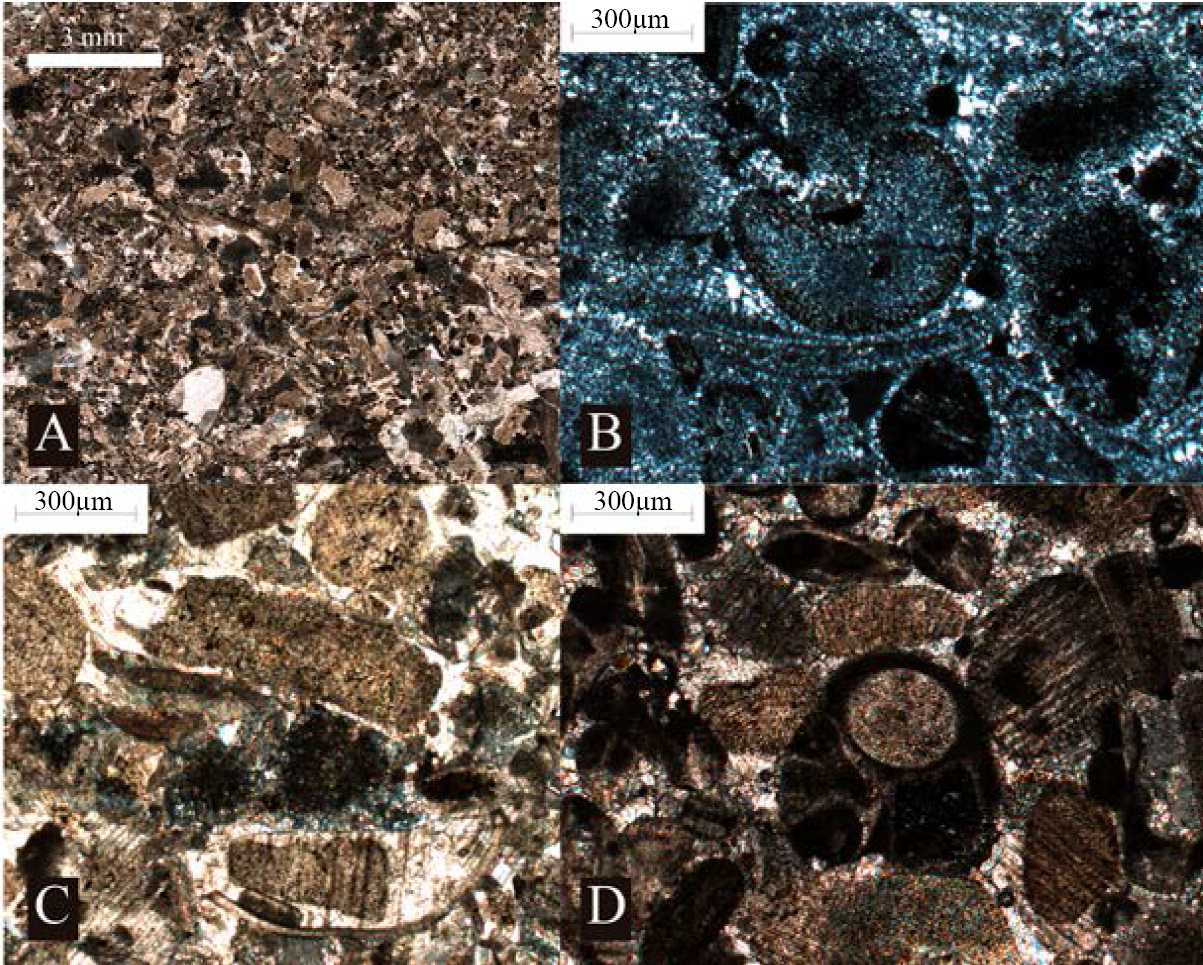
Figure 4 FA1: Grainstone/rudstone with abundant crinoids. (A) Sample LJ 4, reconstruction after 2x images; (B) sample LJ 10; (C) sample LJ 15; (D) sample LJ 36.
FA2. Packstone of pellets/peloids (Figure 5). Sam-ples with abundant pellets/peloids and sand grains with fauna consisting of crinoids, foraminifera, and sponge spicules. On this association, crinoids are not as abundant as in FA1. Due to the presence of sponge spicules and a great quantity of pellets, FA2 is interpreted as belonging to a restricted lagoon in the platform (FZ8). The presence of terrigenous material indicates a proximity to the land; the good sorting indicates a local reworking.
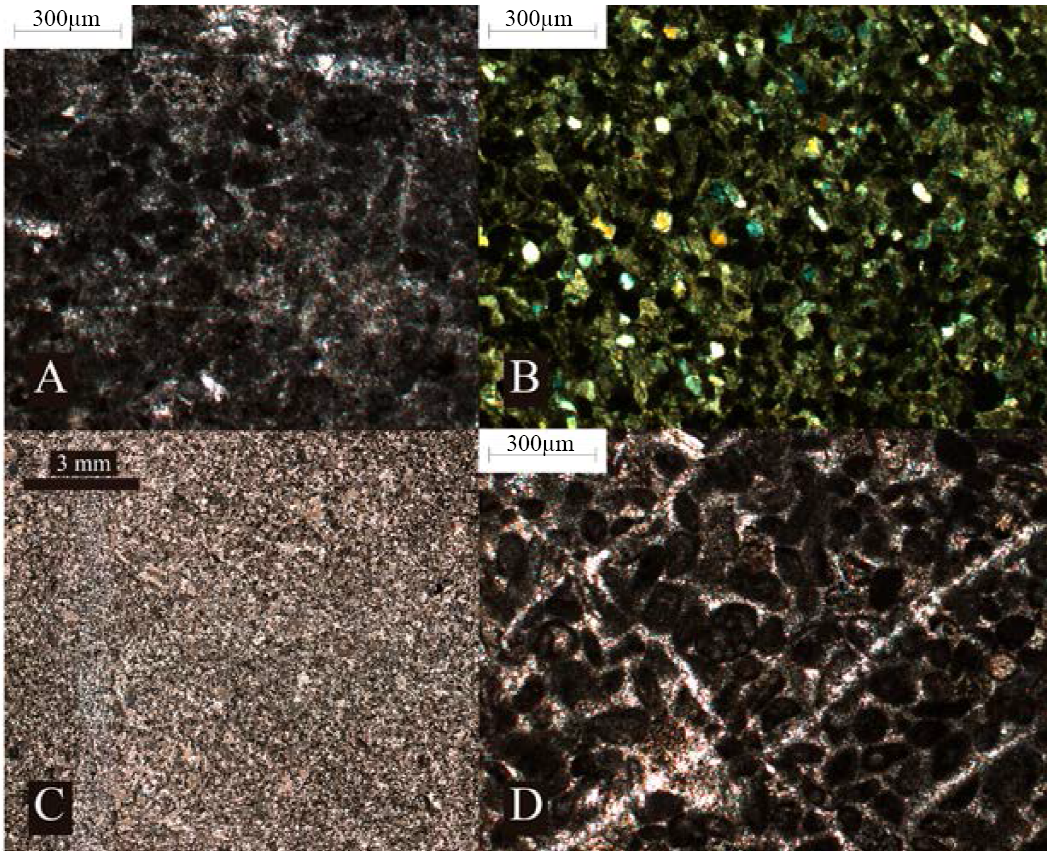
Figure 5 FA2: Packstone of pellets/peloids. (A) Sample LJ 8; (B) sample LJ 31; (C) sample LJ 34, reconstruction after 2x images; (D) sample LJ 64.
FA3. Grainstone with coated bioclasts and peloids (Figure 6). As in FA2, peloids are a very important component, and cortoids made up of bioclasts coated by micritic layers are also significant. Algae, benthic foraminifera, and crinoids are common, whereas ooids and Girvanella oncoids are rare. FZ6: sand banks on platform margin with constant wave action, at or above the fair-weather wave base.
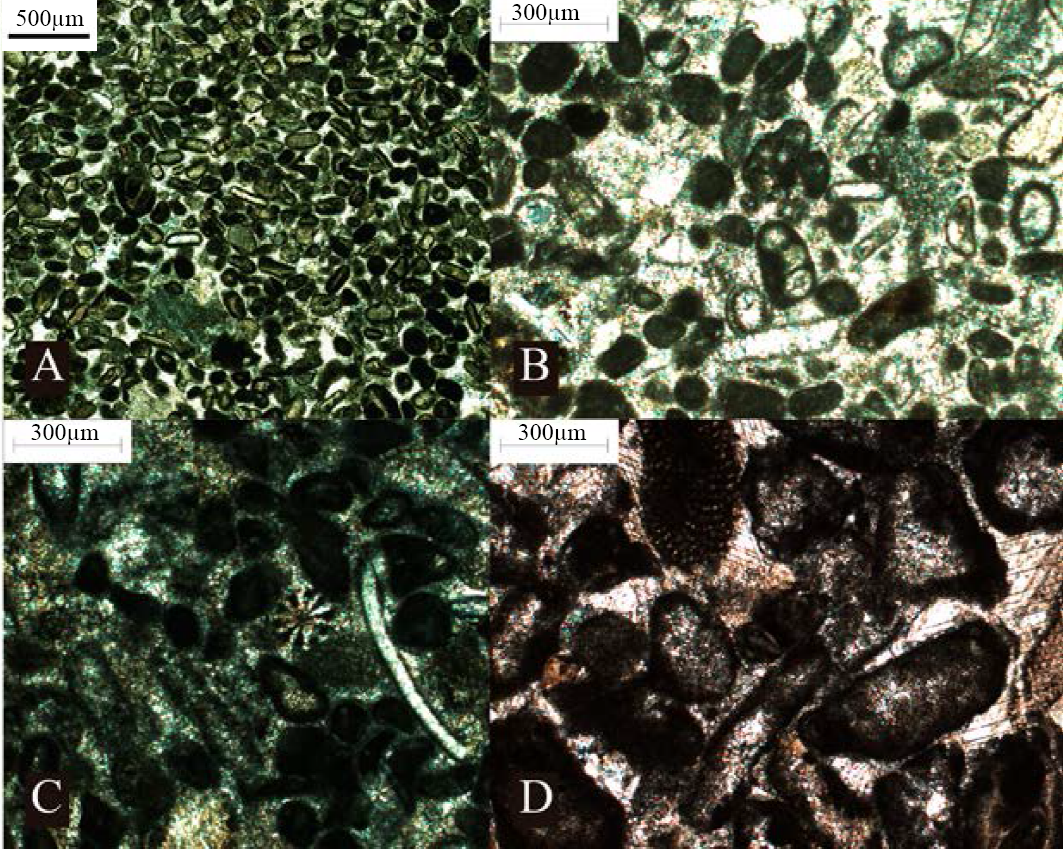
Figure 6 FA3: Grainstone with coated bioclasts and peloids. (A) Sample LJ 3, reconstruction after 4x images; (B) sample LJ 41; (C) sample LJ 42; (D) sample LJ 52.
FA4. Wackestone/floatstone of sponge spicules and fragmented and disarticulated remains of crinoids, brachiopods, and ostracods (Figure 7). Typical facies of slope and lagoonal environments with mud-supported textures and elements proceeding from the reefal crest and the platform margin, that fall down into the slope (fore reef position) or into the lagoon (back reef position), such as crinoid and brachiopod remains, as well as lithoclasts in a brecciated fabric. FA4 is interpreted as a lagoon with open circulation (FZ7) because of a lack of evidence of slope environments in neighbor microfacies.
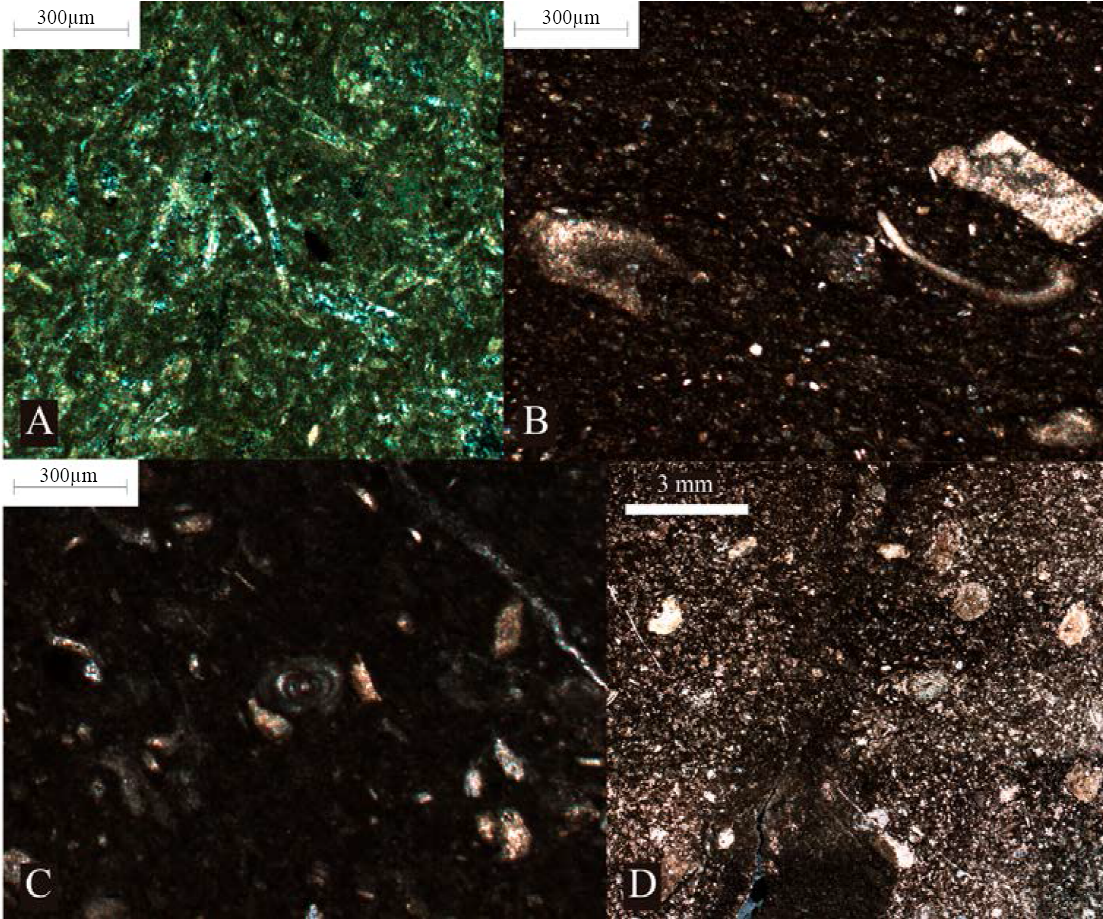
Figure 7 FA4: Wackestone/floatstone of sponge spicules and fragmented and disarticulated remains of crinoids, brachiopods, and ostracods. (A) Sample LJ 30; (B) sample LJ 47; (C) sample LJ 48; (D) sample LJ 49, reconstruction after 2x images.
FA5. Grainstone/rudstone and floatstone with lagoonal fossils (Figure 8). Facies with crinoids and brachiopods, as well as typical fauna from lagoonal environments, such as foraminifera, bryozoans, bivalves, gastropods, and echinoids. Also, non-skeletal elements as cortoids and intraclasts are found. Unlike FA1, this association is rich in textures with wackestone/floatstone type, meaning that they are poorly washed due to the position in a lagoon with lower wave influence. The important occurrence of foraminifera allows allocating this association in the FZ7 (open marine lagoon).
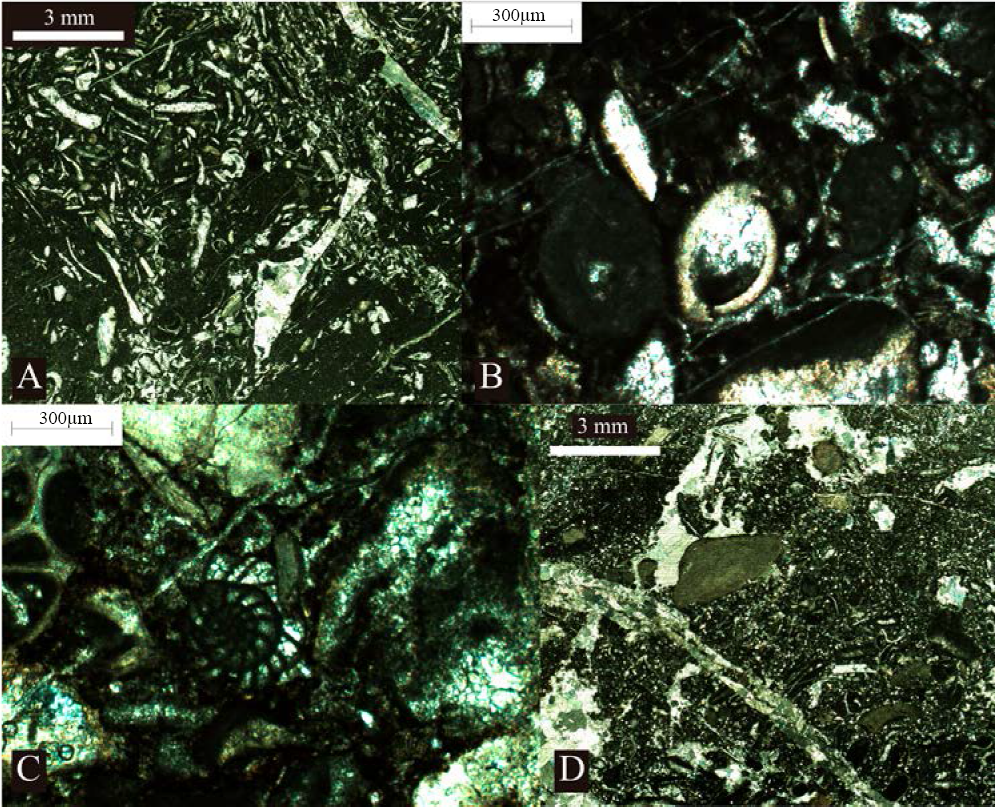
Figure 8 FA5: Grainstone/rudstone and floatstone with lagoonal fossils. (A) Sample LJ 54; (B) sample LJ 56; (C) sample LJ 57; (D) sample LJ 62, reconstruction after 2x images.
FA6. Grainstone with crinoids and pellets (Figure 9). In contrast to FA1, this association contains crinoids surrounded by pellets, with a higher amount of micritic mud. It is considered intermediate between FA1 and FA2, for it does not contain as much crinoids as FA1, nor as much pellets as FA2. Sponge spicules are present in some samples of this association. FZ5: platform reefal margin.
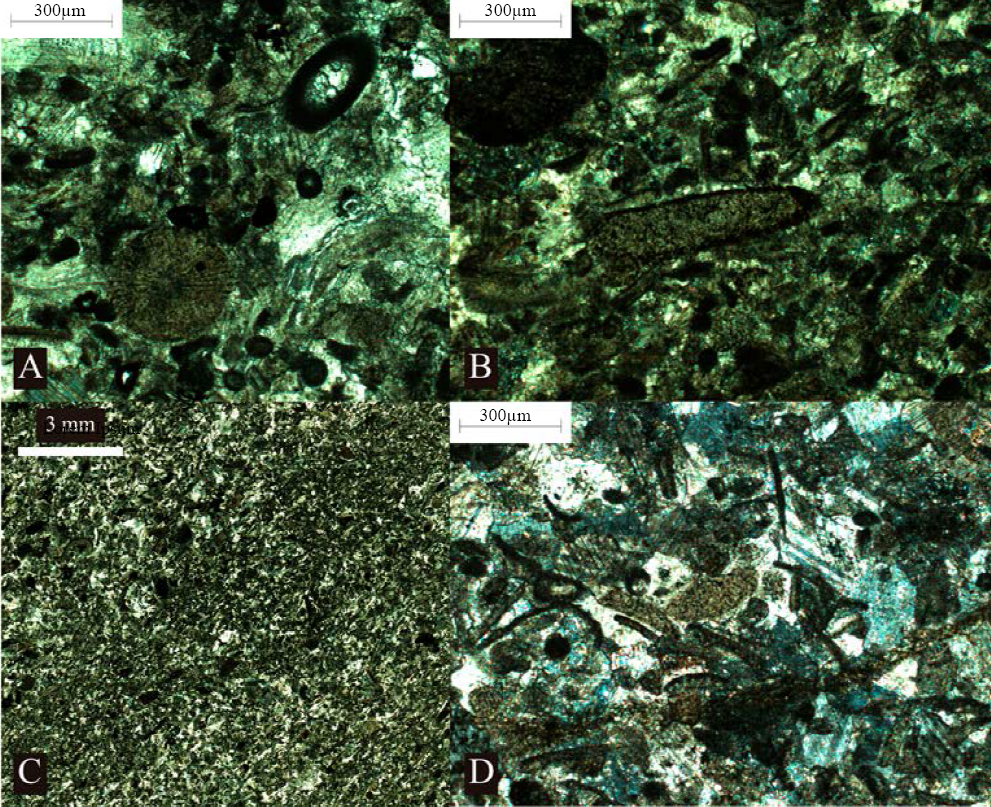
Figure 9 FA6: Grainstone with crinoids and pellets. (A) Sample LJ 5; (B) sample LJ 11; (C) sample LJ 11, reconstruction after 2x images; (D) sample LJ 12.
FA7. Packstone/grainstone with abundant benthic foraminifera and algae (Figure 10). Some of the foraminifers seem abraded and broken, which indicates they underwent some transport from high-energy to low-energy environments in an open-circulation lagoon (FZ7).
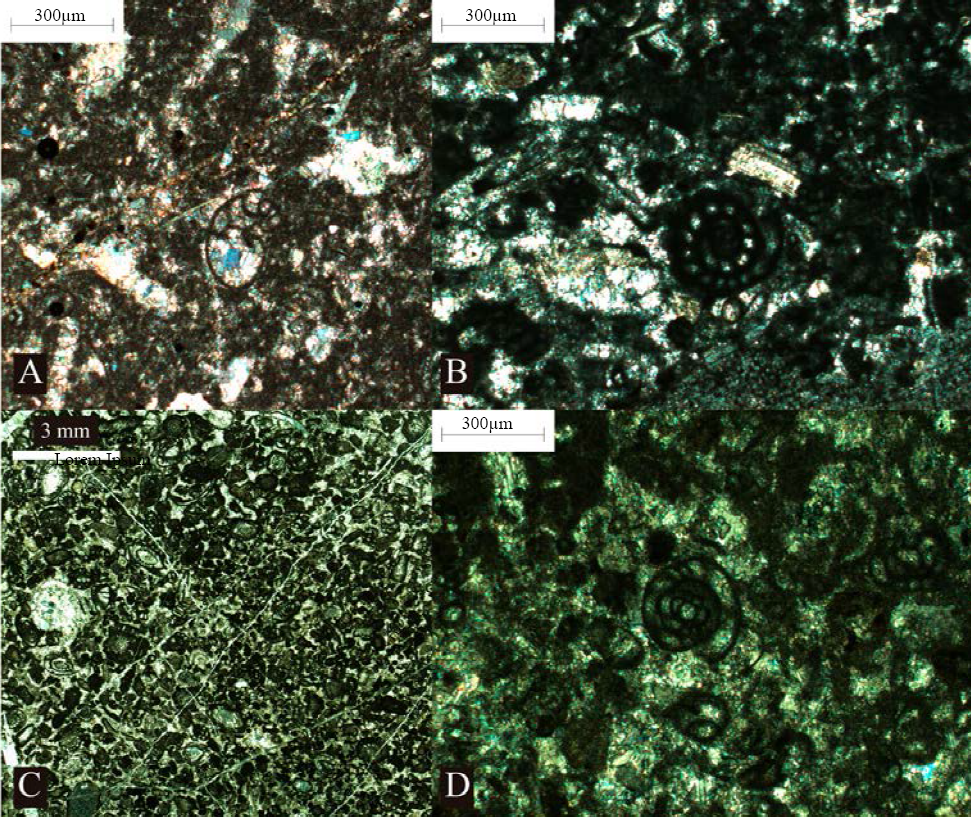
Figure 10 FA7: Packstone/grainstone with abundant benthic foraminifera and algae. (A) Sample LJ 43B; (B) sample LJ 44; (C) sample LJ 63, reconstruction after 2x images; (D) sample LJ 63bis.
FA8. Mudstone/wackestone with scarce fossil content (Figure 11). Facies with small quantities of fossils corresponding to sponge spicules and crinoids, and trace elements of ostracods. Some samples have diagenetic alteration (i.e. dolomitization and silicification), although this does not prevent the recognition of deposit facies. It is associated with SMF 1 “spiculite wackestone/packstone” due to the presence of sponge spicules, and with SMF 23 “Non-laminated homogenous micrite or micro-sparite without fossils” due to mud-supported texture without fossils. Although SMF 1 is typical of deep environments, it is also found in protected shallow platform environments (Flügel, 2010). FZ8: restricted-circulation lagoon.
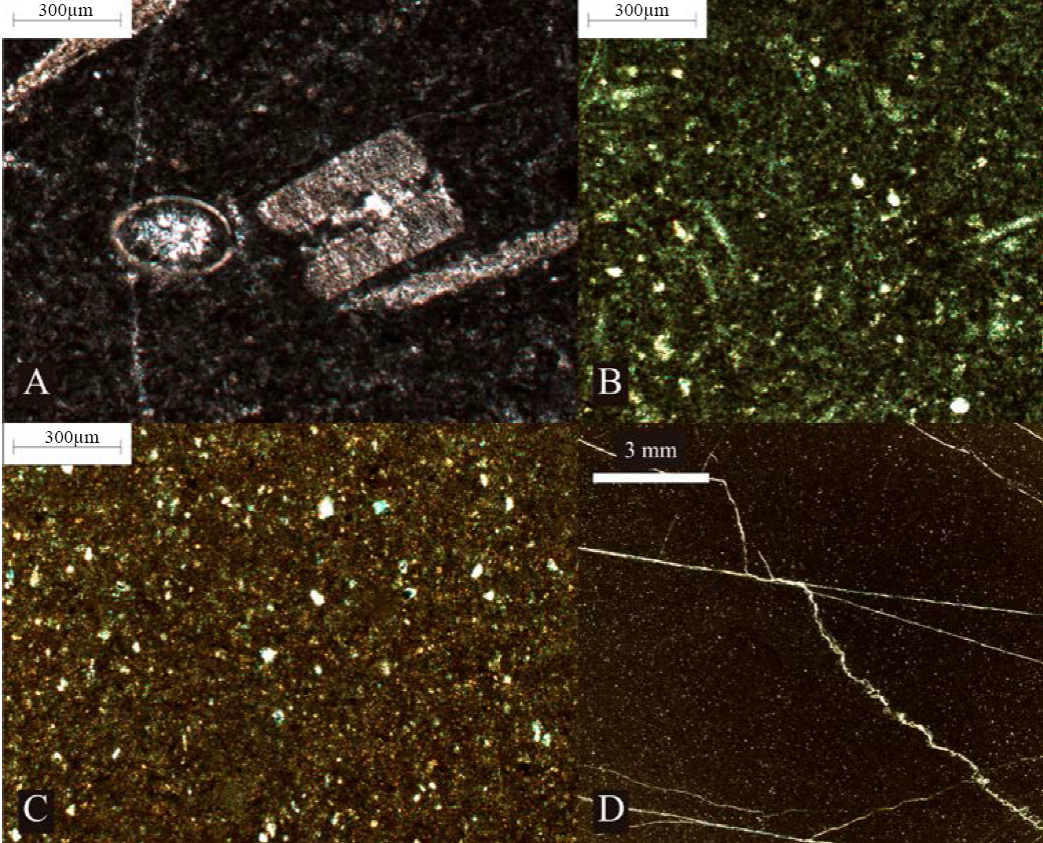
Figure 11 FA8: Mudstone/wackestone with scarce fossil content. (A) Sample LJ 51; (B) sample LJ 55; (C) sample LJ 6; (D) sample LJ 60, reconstruction after 2x images.
FA9. Laminated peloidal bindstone (Figure 12). This FA is assigned to the SMF 16-L because of the presence of micritic laminae composed of mud peloids. In addition, sand grains from land erosion, as well as some intraclasts, are common elements. This facies appears as pelsparite laminae alternating with pelmicrite laminae of microbial origin, with peloids spreading out fully and homogeneously. FZ8: restricted-circulation lagoon.
4.2. Stable isotope analysis
The values obtained for the analysis of 13C/12C and 18O/16O ratios are given in Appendix 1. The corresponding curves (Figure 13) are compared with the distribution of the different facies associations and Wilson’s (1975) facies belts throughout the stratigraphic section, which are considered paleobathymetrical indicators.
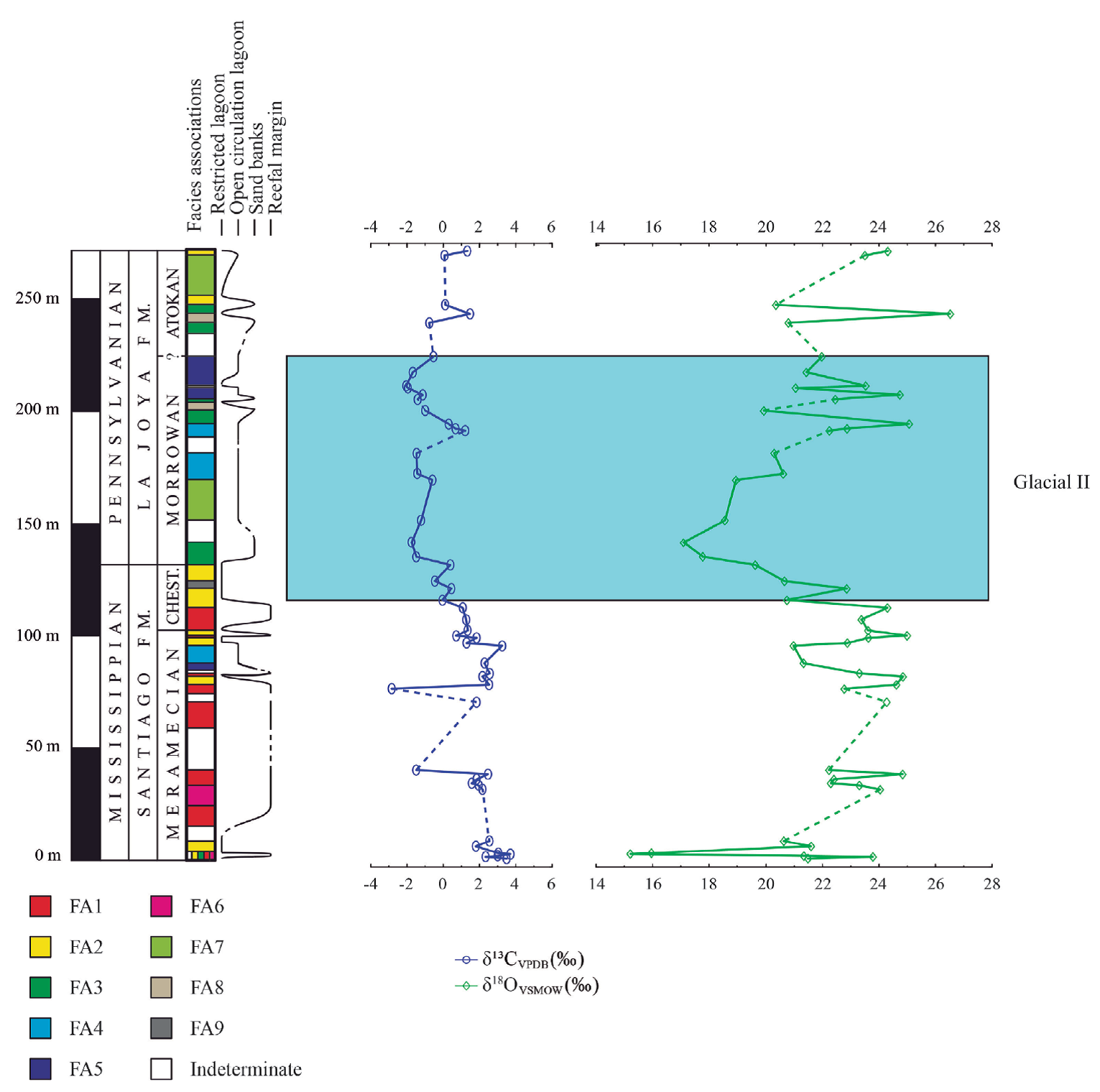
Figure 13 δ18O and δ13C values recorded in samples of the La Joya section compared with the different facies associations, the paleobathymetric curve, as well as the presumable position of Isbell et al. (2003) glacial events. The dash lines indicate strata with diagenesis (dolomitization or silicification) that were not sampled.
At the base of the section, in the Meramecian stage, δ13C values range from 1 to 4 ‰ except for two peaks that lower the δ13C to less than -1.49‰ and -2.85‰. After those negative excursions, values recover up to 2 to 3‰. The Chesterian stage starts with a δ13C of 1.35‰ and henceforth, values do not change significantly. At the beginning of Morrowan stage, δ13C decreases from 0.39‰ to -1.75‰ and it recovers until reaching a peak of 1.2‰, after which levels decrease to -2.04‰, a little before the tentative Morrowan-Atokan boundary at the upper part of the section. In the presumable Atokan, values increase to 1.48‰. These values are lower than those calculated in other Carboniferous localities (Brand, 1989; Mii et al., 1999; Veizer et al., 1999; Saltzman, 2005).
With regard to δ18O values, some abrupt changes can be observed at the base of the section, being the most abrupt of all, that of the 21.3 to 15.2‰ from sample LJ 4 to LJ 5. After that, the tendency is a recovering of values that reached almost 25‰ during the Meramecian. A little negative excursion continues and, by the end of the Meramecian, a new raising in δ18O values can be observed. For the Chesterian, the tendency is a lowering of the values whose minimum level extended into the lowermost Morrowan (Lower Pennsylvanian) with values around 17‰. This negative excursion is followed by a positive one with changing values but which, ultimately, brought the curve until a maximum value of 25‰. At the presumable Atokan, δ18O values changed more abruptly but, in any case, they were still high.
5. Discussion
Examining the paleobathymetric curve based on microfacies analysis (Figure 13), we interpret the Mississippian strata to have been deposited in offshore areas, nearby the platform margin. This can be confirmed with the high frequency of FA1, which is typical of margin platform environments (grain-supported textures with abundant crinoids). At the end of the Meramecian and at the Chesterian, abrupt facies belt and facies zone changes are recorded, along with shallowing sea level. Common facies associations at this interval are FA2 (packstones of pellets) intercalated with FA1 and others less abundant like FA4 (wacke-stone or floatstone of fragmented fossils such as sponges, crinoids, brachiopods, and ostracods) or FA5 (grainstone or rudstone and floatstone with lagoonal fossils), which are typical of nearshore lagoonal environments (either with restricted or open circulation). At the onset of the Morrowan, typical lagoonal associations (FA 7, 4, 5 ) are present with some intercalations of marginal facies (FA3). This means that the changes, previously identified for the latest Meramecian and Chesterian, stopped during most of the Morrowan, when constant shallower lagoon conditions were established in the platform, as can be seen in the paleobathymetric curve. At the end of the Morrowan and during the segment of the Atokan included in the section, some little changes in microfacies are recorded, but with a tendency towards a shallower nearshore restricted platform. This pattern is thought of as a sea level decrease during Early Pennsylvanian that can be correlated with the onset of the glacial event II reported by Isbell et al. (2003), and compared with the positive δ18O excursion. Several authors have reported the occurrence of glacial deposits along the Pennsylvanian in outcrops corresponding to Gondwana (Veevers and Powell, 1987; Fielding et al., 2008; Henry et al., 2008; Holz et al., 2008; Martin et al., 2008; Rocha-Campos et al., 2008; among others). During this time, Gondwana underwent various episodes of glaciations that caused important sea level regressions resulting in positive δ18O excursions, as more of the 16O was trapped in ice caps during glaciation times (Joachimski et al., 2006).
Another goal of this study is to know the behavior of δ13C and δ18O isotope values to compare with data from other parts of the world and elucidate a regional or global pattern. Nonetheless, in order to rule out a diagenetic imprint in our samples, a crossplot of δ18OVSMOW against δ13CVPDB values was made (Figure 14). According to some authors (Banner and Hanson, 1990; Titschak et al., 2009; Seuss et al., 2012) a direct covariance of both δ13C and δ18O is evidence of diagenetic alteration affecting both isotopic signatures. However, no covariance is clear from our results, and the resulting correlation coefficient value of 0.14 indicates that there is no correlation between the calculated δ13C and δ18O values; thus, it is interpreted as no evidence of diagenetic alteration recorded in the isotopic composition.
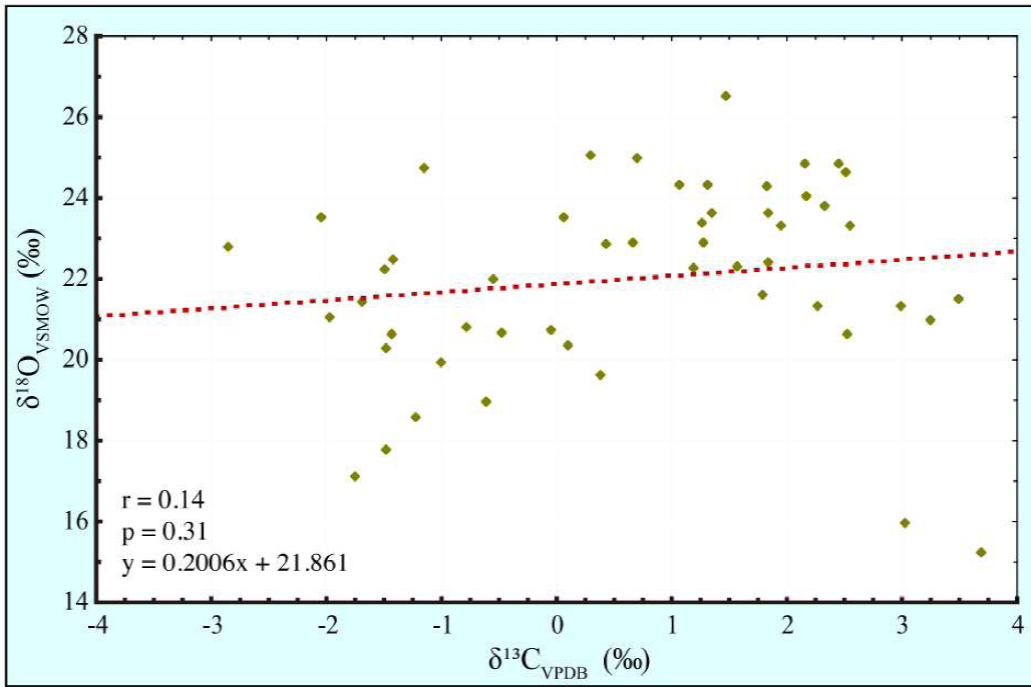
Figure 14 Crossplot of δ18O vs δ13C showing no direct correlation as evidenced for the almost horizontal regression line (slope of 0.2) and the r coefficient indicating a value close to 0. The p-value of 0.31 supports the lack of correlation between the isotopic values.
The δ18O signal is more susceptible to diagenetic alteration in bulk rock sampling than δ13C, and this is reflected in the maximum difference found between the lower and higher δ18O values. For δ18OVSMOW, the maximum value is 26.52‰ and the minimum is 15.22‰, with a difference of 11.30‰, which is wide enough to be considered a reliable proxy of the original seawater com-position. However, assuming the samples have been altered evenly, we can infer some patterns. For example, the Meramecian is characterized for several peaks in the δ18O signal with relatively high values, except for some lower values at the beginning of the section. These high values could be associated with cooling temperatures, and the peaks, with short time intervals of warming. The evidence in other parts of the world indicate that Meramecian was not a glacial age (Mii et al., 1999; Isbell et al., 2003; Fielding et al., 2008; Frank et al., 2008; among others), as it lies between the Glacial I (Late Devonian-Early Mississippian) and Glacial II events proposed by Isbell et al. (2003), so that the δ18O signal would record only a drop in temperatures and not glacial events as such.
At the beginning of the Chesterian, a negative δ18O excursion can be drawn that reached its minimum in the lowermost Morrowan. This event could be interpreted as a warming period, with ice cap melt raising 16O in seawater, thus lowering δ18O. Immediately, we can distinguish an increase that correlate with the global increase that occurred at the onset of the Pennsylvanian and that corresponds to the glacial event II of Isbell et al. (2003). The change in facies association towards nearshore environments confirms a sea-level decrease that might have been caused by this glacial event. The rest of the Morrowan and Atokan is characterized by abrupt changes in the δ18O values. Oxygen isotopes are sensitive to many other events besides glacial formation and melting. For example, the amount of fresh water coming into the marine platform can modify δ18O, because continental runoff is enriched in 16O relative to ocean water, and ultimately this would cause a δ18O drop in ocean water. This also affects salinity as freshwater runoff (16O enriched) reaching the sea, lowers seawater salinity and hence, 18O levels (Joachimski et al., 2006). However, these authors consider that salinity does not account for much of δ18O variation in low-latitude surface waters, as it does surface water temperature and ice volume. Because the microfacies analysis assumes environments close to the shoreline, the influence of continental fresh water is presumed to be important, leading to a local or regional variation in δ13C and δ18O values.
For the δ13C isotope curve, we compared our results with those of bulk rock data reported by Saltzman (2005) in the Great Basin, United States. For the Osagean-Meramecian, Saltzman showed δ13C values between 1‰ and 3‰, whereas in the La Joya section, the average is, for the Meramecian, between 2‰ and 3‰.
The major difference is found during the Pennsylvanian where Saltzman reported δ13C values that range between 1‰ and 4‰ whereas in the La Joya section, values extend from -2% to 1.5‰, approximately. For the Chesterian stage, the La Joya δ13C values approach those reported by Batt et al. (2007) in east-central Idaho, with an overall pattern towards lower values at the end of the Chesterian from 2‰ to slightly lower than 0‰. This pattern is also recognized in the Chesterian of La Joya (from 1.3‰ to values near -0.5‰), but this interval is very short, indicating that only a portion of Batt et al.’s (2007) Chesterian is repre-sented in our section.
At the beginning of the Morrowan (Pennsylvanian), this tendency disappears, since there is no evidence of the typical positive δ13C excursión reported by many authors in several localities across the world (Mii et al., 1999, 2001; Saltzman, 2005; Batt et al., 2007; Frank et al., 2008; among others). We notice a slight positive excursion well into the Morrowan but not at its onset. The δ18O curve also shows a positive excursion, but it starts slightly after the onset of the Morrowan.
This excursion does not match with that reported in the literature showing its onset at the beginning of the Morrowan (Bashkirian), leading to the conclusion that this excursion is due to a more regional pattern, rather than global. Perhaps, a more exhaustive study in this interval is necessary to elucidate the global pattern.
For some authors (Lowenstam, 1961; Grossman et al., 1996), geochemical composition of brachio-pod shell calcite is a reliable proxy for paleoen-vironmental reconstruction. This assertion was based on the idea that brachiopods precipitate their shells in isotopic equilibrium with seawater. Since they have a low-Mg calcite composition, they are less susceptible to diagenetic alteration in comparison with the aragonite and/or high-Mg calcite composition of other biogenic components in the matrix (Batt et al., 2007). In contrast to this assumption, some studies revealed that brachiopod shells are not always in isotopic equilibrium with ambient seawater, as vital effects change the carbon and oxygen isotope composition (Carpenter and Lohman, 1995; Brand et al., 2015). Therefore, some corrections (Mg-effect) and cautions (avoiding fast-growing areas) to properly interpret the original seawater composition are needed (Brand et al., 2015). This fractionation chiefly depends on what area of the shell is chosen for analysis (primary or secondary layer; Carpenter and Lohman, 1995). Furthermore, some studies demonstrated that bulk carbonates have a continuous and facies-independent record, and therefore they are excellent proxies of seawater δ13C composition (Weissert et al., 1985; Saltzman, 2003; Batt et al., 2007; Liu et al., 2017). For these reasons, and the scarcity of a continuous record of well-preserved brachiopod shells in the study area, a total rock isotopic analysis is used.
Some of the discrepancies observed between this work and others could be assigned to regional or local controls that mask global patterns. In addition to diagenetic overprint, tectonic influences, local changes in productivity, or Corg sequestration, among others, could be mentioned. To reduce the bias caused by diagenesis, the samples were care-fully selected avoiding those of high diagenetic alteration (silicification, oxidization, or dolomitization). Furthermore, in the drilling process, we avoided sampling in calcite veins or areas of evident recrystallization (except for grainstone-texture samples that are cemented by sparite).
During the Pennsylvanian, the eastern part of Sonora was in one end of the Pedregosa Basin (Figure 15), a shallow marine platform that divided the North American Craton from the Rheic Ocean (Palafox-Reyes, 2011). Greenwood et al. (1977) included open-shelf rocks of Pennsylvanian age from southeastern Arizona, south-western New Mexico, and northern Mexico in the extension of the Pedregosa Basin. The shallow facies belts recognized in this study indicate that the La Joya section was part of the shallower area of Pedregosa (Pedregosa shelf according to Armin (1987)). During the Late Paleozoic, some terranes surrounded this basin: the Florida Islands to the northeast, and the Zuni-Defiance uplift and the Sedona arch to the north and northwest.
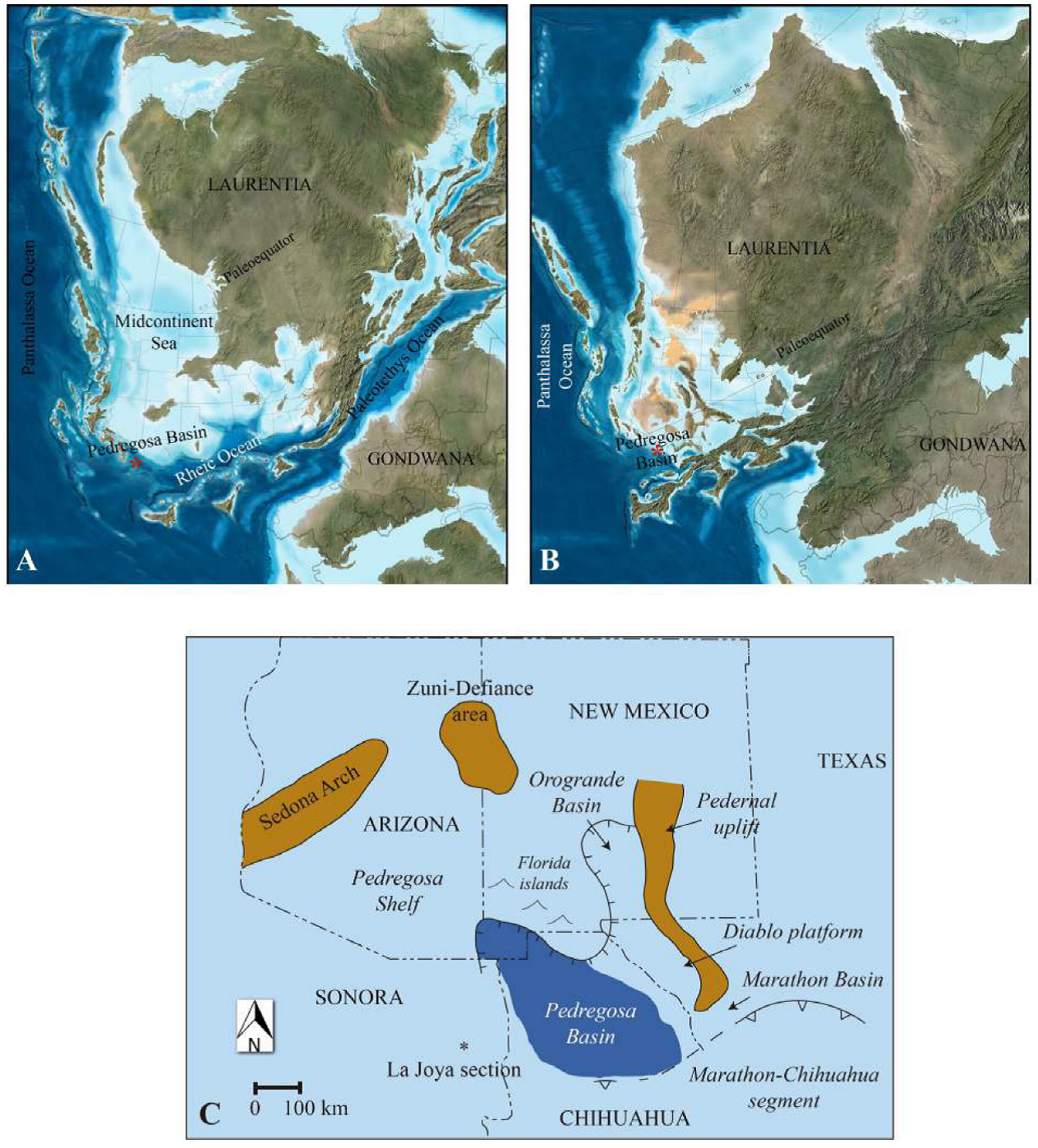
Figure 15 Paleogeographic maps showing the location of the La Joya section (with an asterisk) in the Pedregosa platform of North America during (A) the Early-Middle Mississippian (345 Ma), and (B) the Middle Pennsylvanian (308 Ma). In (C) a reconstruction of tectonic elements present in the late Paleozoic of Sonora. (A) and (B): adapted from Blakey: http://deeptimemaps.com/map-roomindividual/, (C) modified from Armin (1987).
In the southern part, the basin was bordered by the Marathon-Chihuahua segment of the Ouachita orogeny (Armin, 1987, and references therein). According to this model, we propose that the La Joya section was located in the area corresponding to the Pedregosa platform, and in close vicinity with the deeper Pedregosa Basin, both of them somewhat distant from the continental uplifts, which explains the lack of sufficient input of siliciclastics in the platform.
According to Batt et al. (2007) the differences found in δ13C values between Tethyan and Panthalassan brachiopods could be explained by variations across the platform due to differences in residence times of the waters found in restricted platforms, as well as the mixing of water masses isotopically different because of upwelling and freshwater influx. The upwelling process had already been proposed as a likely mechanism that accounted for δ13C differentiation (Mii et al., 1999, 2001; Saltzman, 2003; Liu et al., 2015). These zones of upwelling would have developed due to the closure of the Rheic seaway during the Middle to Late Visean (Meramecian-Chesterian), which reorganized the patterns of ocean circulation and ultimately promoted areas of upwelling in Western Euramerica (Liu et al., 2015). Such differentiation would cause areas in Western Euramerica (Mid-continent U. S.) to have lower δ13C values (a shift of only 1.5‰) with regard to Eastern Euramerica during mid-Carboniferous (a 3‰ increase; Mii et al., 2001). In this context, the lack of a clear positive excursion in δ13C values for the Morrowan of La Joya can be due to a masking of the global pattern, leading by the occurrence of upwelling that brings 12C-enriched nutrients to the sea surface (expressed by lower δ13C values). Also, if there were poor water replacement with open seas, and the proximity to land brought sufficient amount of 12C-enriched sediments, they could hamper the expression of a clear δ13C positive excursion correlated with the onset of the mid-Carboniferous glaciation.
6. Conclusions
The microfacies analysis yields 9 facies associations distributed along the 270 m of the La Joya section in the Mississippian-Pennsylvanian of the Sierra Agua Verde, Sonora. These facies associations span marine paleoenvironments from the marginal reef position up to sand banks and open and restricted lagoons. The paleobathymetric curve constructed after these facies associations indicates deeper conditions during the Meramecian times with abrupt changes during Chesterian and more stable and increasingly shallower waters for the Pennsylvanian, which can be correlated with the onset of glacial II reflected as a global sea-level drop. This decline can be confirmed with a positive excursion in δ18O values during the Mississippian-Pennsylvanian boundary, although for the La Joya section, this pattern is shown at the middle of the Morrowan. More studies are necessary to clarify this discrepancy. When we compare our δ13C values with literature, some differentiations appear. Input of land 12C-enriched fresh water, as well as regional upwelling and long residence times of the seawater in this mostly restricted platform are claimed as causes of the discrepancies.
This work is an approach in the interpretation of paleoenvironmental conditions and more investigation has to be done, particularly with other Sonoran sections, which are poorly studied in a geochemical framework.











 nueva página del texto (beta)
nueva página del texto (beta)

